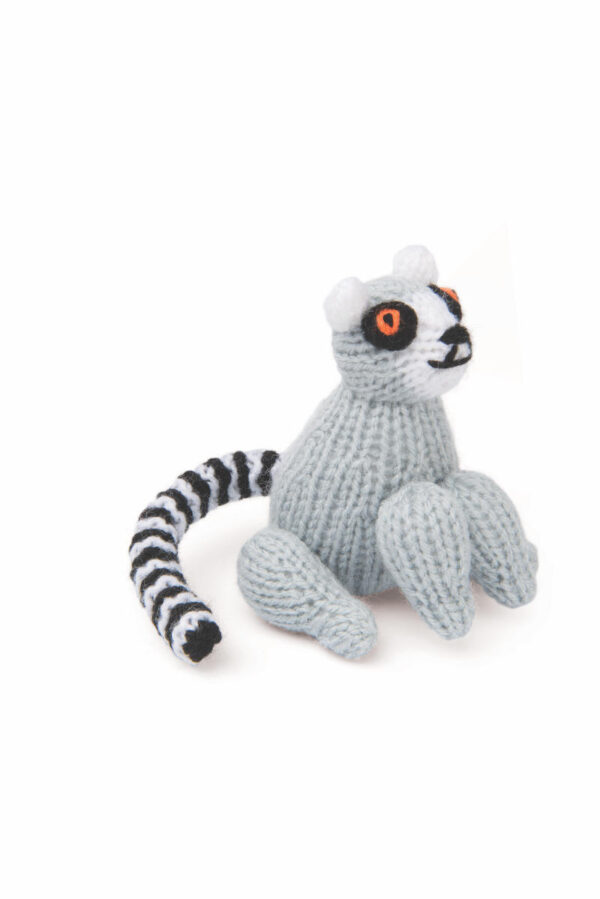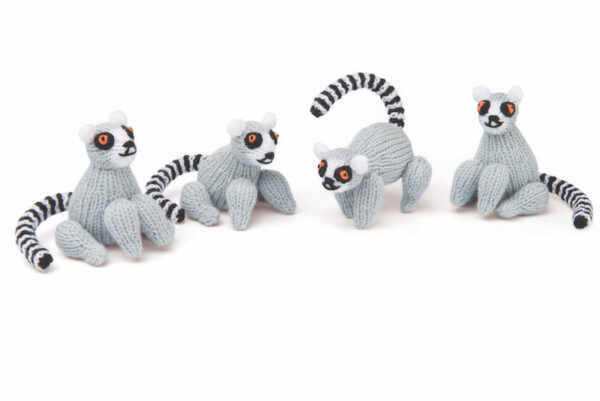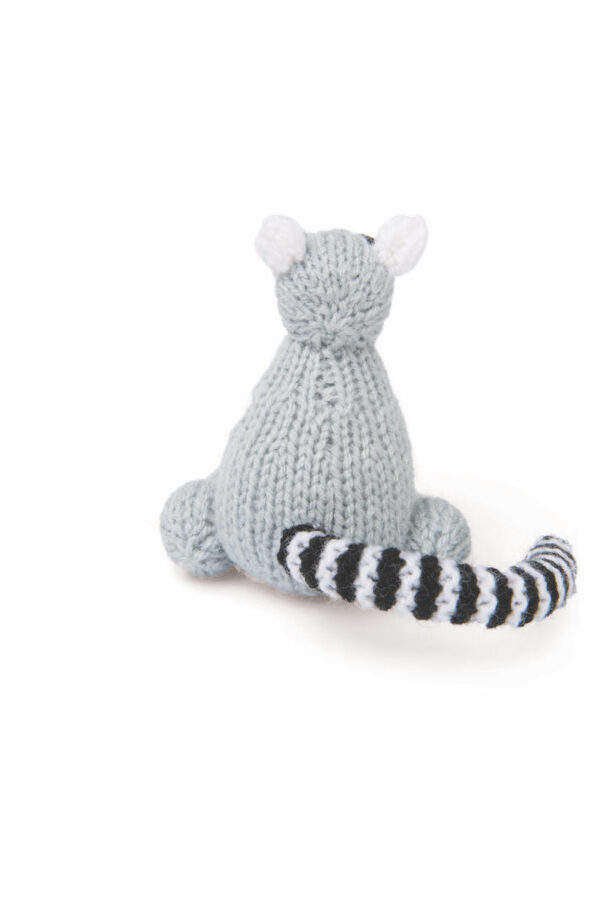If you’re looking for knit amigurumi animal patterns, you’ll want to check out this book review. I’m reviewing a pattern book filled with over 25 knitted animals and safari toys, along with an excerpt for the knitted lemur pattern.
This post contains affiliate links. I may receive compensation (at no added cost to you) if you make a purchase using these links. Guild of Master Craftsman Publications Ltd provided me with a free review copy of Knitted Safari: A Collection of Exotic Knits to Make by Sarah Keen. Although I accept free products for review, I do not accept additional compensation, nor do I guarantee a positive review. My reviews are based entirely on my honest opinions.
Book Review

Knitted Safari: A Collection of Exotic Knits to Make by Sarah Keen is a pattern collection themed around going on an African safari. The book opens with a dedication, table of contents, and brief introduction from Sarah. Then it dives into 15 full-color, full-page photos of the animals in small groups and on a safari mat (one of the included patterns). The pictures of the animals together give you a sense of scale and also include the name of the animal and the page number where you can find the pattern. It would be something fun to flip through with a child to get them excited about picking out the toy(s) you might make them from this book.
The next section, The Projects, includes patterns. There are 25 different animal species included, but several — the elephant, the lion, and the meerkat — include multiple patterns for different members of the animal “family.” There is also a pattern for a 4×4 (the vehicle, not the piece of wood) and a safari mat, which is basically a large play mat in different colors to represent water, jungle, and desert areas. Each pattern includes multiple pictures of the completed project against a white background and “Did You Know?”, a small bit of information about that animal. The “Information you’ll need” includes a materials list, the finished size of the project, the tension (or gauge), and any special abbreviations. All of the patterns use light (DK/#3) weight yarn. The safari mat pattern uses US 10 (6 mm) knitting needles, while the remaining patterns use US 3 (3.25 mm) knitting needles. Each pattern then moves on to “How to make” instructions. Each project is knit flat and seamed. After each pattern, there is a “Making up” section with detailed instructions for assembly. The book is written in UK terminology, but there are conversions and a glossary to US terms in the back matter.
The next section is Techniques. “Getting started” shares information about yarn and tension (gauge), as well as safety tips for making toys for young children. There are written and color illustrations to describe the slip knot, long tail cast on, knit stitch, purl stitch, k2tog decrease, 2-needle cast on, casting off (binding off), three stitches (mattress, over-sewing, and back stitch) and three embroidery stitches (chain stitch, back stitch, and stem stitch) used for assembly and embellishment. There are also written instructions for garter stitch, stocking (stockinette) stitch, rib, and moss stitch, the M1 and kfb increases, tassels, and explanations of using Fair Isle (stranded) and intarsia color knitting. This section ends with a detailed list of abbreviations, US/UK/metric needle conversions and US/UK knitting terminology. The book finishes with a detailed index. Although this section is illustrated, it assumes the reader has basic beginner-level knitting skills and is more of a refresher than a “learn to knit” section.
What I Liked About This Book
- There are a lot of clear pictures and many of them seem to be aimed at young children who may not be able to knit, but would be able to pick out animals they are interested in seeing as toys.
- The patterns are knitted flat and beginner friendly.
- The book includes over 27 patterns at an affordable price.
- Although it’s a paperback and doesn’t lay flat so you can read while you knit, there are cover flaps on both sides so you can “mark” two different pages (such as the pattern and the abbreviation list) as you work.
- No specific brand of yarn is mentioned so it’s easy to substitute a yarn in your stash in the specified color(s).
- The animals are themed to a particular continent and include facts, so they are helpful for teaching children about nature and the world.
I’m not sure if this is a cultural thing as the book publisher (and author, I think) are located in the UK, but one thing that I made me uneasy was the use of “exotic” and “safari” in a book about African animals, and the inclusion of the truck pattern (for hunting? for observing?). I think if the book was called Animals of Africa in Amigurumi or something like that, I would feel more comfortable about it. With that being said, the book itself, though visually appealing for children, is not written for children. As the adult, you can present the information in any way you choose and which feels comfortable for you, or you can just share the toys and not the book with anyone you make these projects for.
If you like knitting animals, or want to try, I recommend Knitted Safari: A Collection of Exotic Knits to Make by Sarah Keen. There is a great variety of animals, including both predators and herbivores, to please everyone.
Lemur
Knitted Lemur Pattern by Sarah Keen
Published in Knitted Safari: A Collection of Exotic Knits to Make

Text © Sarah Keen, 2018. Copyright in the Work © GMC Publications, Ltd, 2018 Shared with permission from GMC Publications, Ltd.
Notes from Underground Crafter
- This pattern uses standard UK knitting pattern abbreviations. You can find a list of US abbreviations with a key to US to Canada terms here; these same differences apply to the UK terms.
- A chenille stem is also known as a pipe cleaner.
- B.Hooked has a helpful video tutorial for the long tail cast on method here.
- Fiber Flux has a helpful k2tog video tutorial here.
- Very Pink Knits has a helpful M1 video tutorial here.
- You can find a helpful mattress stitch tutorial here.

Information you’ll need
Materials
- Any DK (US: light worsted) yarn (amounts given are approximate):
- 10g silver grey (A)
- 5g white (B)
- 5g black (C)
- Oddments of black and orange for embroidery
- 1 pair of 3.25mm (UK10:US3) needles
- Knitters’ pins and a blunt-ended needle for sewing up
- Tweezers (optional)
- 1 chenille stem per Lemur
- Acrylic toy stuffing
Finished size
- Lemur stands 3.6in (9cm) high
Tension
- 26 sts x 34 rows measure 4in (10cm) square over st-st using 3.25mm needles and DK yarn before stuffing
Did you know?
- Lemurs are really clever – they can even understand basic maths!

How to make Lemur
Body
- Using the long tail method and A, cast on 8 sts.
- Row 1 and foll 2 alt rows: Purl.
- Row 2: (Kfb) to end (16 sts).
- Row 4: (Kfb, k1) to end (24 sts).
- Row 6: (Kfb, k2) to end (32 sts).
- Rows 7 to 17: Beg with a p row, work 11 rows in st-st.
- Row 18: (K2tog, k2) to end (24 sts).
- Rows 19 to 21: Beg with a p row, work 3 rows in st-st.
- Row 22: (K2tog, k1) to end (16 sts).
- Rows 23 to 27: Beg with a p row, work 5 rows in st-st.
- Cast off.

Head
- Using the long tail method and A, cast on 8 sts.
- Row 1 and foll alt row: Purl.
- Row 2: K1, (m1, k1) to end (15 sts).
- Row 4: K1, (m1, k2) to end (22 sts).
- Rows 5 to 9: Beg with a p row, work 5 rows in st-st.
- Row 10: K4, (k2tog, k1) 5 times, k3 (17 sts).
- Row 11: Change to B and p 1 row.
- Row 12: K5, k2tog, k3, k2tog, k5 (15 sts).
- Row 13: Purl.
- Row 14: (K2tog, k1) to end (10 sts).
- Row 15: Purl.
- Thread yarn through sts on needle, pull tight and secure by threading yarn a second time through sts.
Hind legs (make 2)
- Using the long tail method and A, cast on 10 sts.
- Rows 1 to 3: Beg with a p row, work 3 rows in st-st.
- Row 4: (K2tog) twice, m1, k2, m1, (k2tog) twice (8 sts).
- Row 5 and foll 3 alt rows: Purl.
- Row 6: K2tog, k1, m1, k2, m1, k1, k2tog (8 sts).
- Row 8: K1, (m1, k2) 3 times, m1, k1 (12 sts).
- Row 10: K5, m1, k2, m1, k5 (14 sts).
- Row 12: K6, m1, k2, m1, k6 (16 sts).
- Rows 13 to 15: Beg with a p row, work 3 rows in st-st.
- Row 16: (K2tog, k2) to end (12 sts).
- Row 17: Purl.
- Row 18: (K2tog) to end (6 sts).
- Thread yarn through sts on needle and leave loose.
Forearms (make 2)
- Using the long tail method and A, cast on 8 sts.
- Rows 1 to 3: Beg with a p row, work 3 rows in st-st.
- Row 4: K3, m1, k2, m1, k3 (10 sts).
- Row 5: Purl.
- Row 6: K4, m1, k2, m1, k4 (12 sts).
- Rows 7 to 13: Beg with a p row, work 7 rows in st-st.
- Row 14: (K2tog) to end (6 sts).
- Thread yarn through sts on needle and leave loose.
Eye patches (make 2)
- Using the long tail method and C, cast on 10 sts.
- Thread yarn through sts on needle, pull tight and secure by threading yarn a second time through sts.
Ears (make 2)
- Using the long tail method and B, cast on 7 sts.
- Row 1 and foll alt row: Purl.
- Row 2: K2, m1, k3, m1, k2 (9 sts).
- Row 4: K1, k2tog, k3, k2tog, k1 (7 sts).
- Thread yarn through sts on needle, pull tight and secure by threading yarn a second time through sts.
Tail
- Using the long tail method and C, cast on 8 sts and work in g-st.
- Rows 1 and 2: Join on B and work 2 rows in g-st.
- Rows 3 to 48: Work in g-st stripes, carrying yarn loosely up side of work, 2 rows C, then 2 rows B, and do this alternately for 46 rows, finishing with 2 rows C.
- Row 49: Using B, k 1 row.
- Using B, cast off in g-st.

Making up
Note: Sew up all row-end seams on right side using mattress stitch one stitch in from the edge, unless otherwise stated; a one-stitch seam allowance has been allowed for this.
Body
Gather round cast-on stitches, pull tight and secure. Sew up row ends of body and stuff body.
Head
Gather round cast-on stitches of head, pull tight and secure. Sew up row ends leaving a gap, stuff and sew up gap. Sew head to neck of body.
Hind legs and forearms
Gather round cast-on stitches of hind legs and forearms, pull tight and secure. Sew up row ends, stuff with tweezers or tip of scissors and pull stitches on a thread tight and fasten off. Place Lemur on a flat surface, assemble hind legs and forearms, and sew to body.
Eye patches
Sew together row ends of cast-on stitches. Sew eye patches to head.
Ears
Sew up row ends of ears and sew ears to head.
Features
Embroider eyes in orange at centre of eye patches. Make a chain stitch for each eye and a second chain stitch on top of first. Make a tiny stitch in black at centre of eyes. Embroider nose and mouth in black using satin stitch and straight stitches.
Tail
Gather round cast-on stitches of tail, pull tight and secure. Fold chenille stem in half and place on wrong side of tail. Sew up row ends along length of tail, enclosing chenille stem inside. Cut chenille stem to length of tail and sew tail to back of Lemur.

Looking for more knit amigurumi inspiration? Follow my Amigurumi – Knit Pinterest Board!

